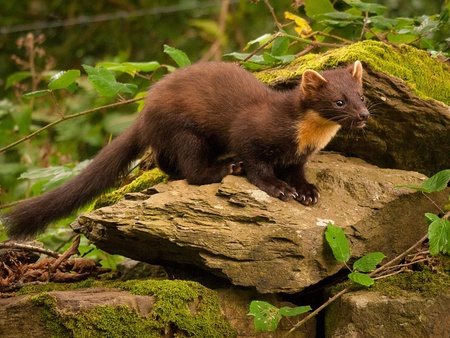A new study published today (March 7) has shown that pine martens can help in the conservation of red squirrels - by reversing the spread of invasive grey squirrel populations.
Scientists from the University of Aberdeen, Waterford Institute of Technology and the University of Massachusetts Amherst have published their study ‘The enemy of my enemy is my friend: native pine marten recovery reverses the decline of the red squirrel by suppressing grey squirrel populations’, in the journal Proceedings of The Royal Society – B.
The study, which was led by Dr Emma Sheehy and Professor Xavier Lambin from the University of Aberdeen’s School of Biological Sciences, used DNA forensics and state of the art analyses to test the hypothesis that pine martens are suppressing grey squirrel populations in Scotland.
The research took place in the Scottish Borders - an area which pine martens have recently begun to recolonise, Central Scotland - where there is a more established pine marten population - and in the Highlands, where there are no grey squirrels but a long established pine marten population coexists with native red squirrels.
223 multi-species feeders were deployed throughout the three regions, baited with a mixture of nuts and seeds. Sticky patches placed under the lid collected hair samples from squirrels and pine martens that took the bait. Trail cameras were also used to improve detectability of red squirrels in particular, who often didn’t leave hair behind as pine martens had saturated the sticky patches with their hair before red squirrels got there.
The study built on evidence from a 2014 study, which suggested that pine martens may be responsible for the decline of grey squirrels in Ireland, and confirms that the relationship between red and grey squirrels in the UK is clearly altered in the presence of a native predator.
Dr Chris Sutherland of the University of Massachusetts Amherst explains: “Studying wildlife can be difficult, particularly when investigating multi-species relationships. As such our study offers what is a very rare insight into the potential role of native predators in shifting dynamics between native and invasive prey species.
“With the hair samples collected, DNA forensics were used to identify individual pine martens and spatial statistical models were then used to reconstruct individual pine marten home ranges. From this we were able to quantify how much red and grey squirrels were exposed to these pine martens, and most importantly, how this is affecting their distribution.
Dr Sheehy said: “Our study has confirmed that exposure to pine martens has a strong negative effect on grey squirrel populations, whereas the opposite effect was observed in red squirrel populations who actually benefitted from exposure to martens.
“Our occupancy modelling offered further insight into the possible mechanism at play. There are two steps to occupancy models, first determining the factors which affect the probability of detecting a species, given they are present, and second the probability that the focal species actually occupy the site. The detection component of our models showed that where pine marten activity was high, red squirrels took longer to use the feeders, which suggests red squirrels modify their behaviour to be more cautious when their natural predator is around.
“This type of behaviour is to be expected from species that have co-evolved together On the other hand, no such caution was identified in the grey squirrel population, which suggests they may be easier prey to find, and much more susceptible to predation by pine martens. This is a really interesting result, and contradicts the “landscape of fear” theory which suggests grey squirrels are avoiding pine martens rather than being heavily preyed upon. However, further research is needed in order to define the exact mechanisms taking place.
“Our evidence that, in addition to their intrinsic value, pine martens provide an ecosystem service by suppressing invasive grey squirrel populations is good news for both red squirrel conservation efforts and the timber growing industry, due to the detrimental impact of the invasive grey squirrel on both. The pine marten is already heavily suppressing grey squirrel populations where they are well established, and presumably this influence will spread as the pine marten’s range expands southwards through Scotland and into the North of England but this is likely to be a slow and very gradual process.”
The study took place between 2014 and 2017 and was funded by the Irish Research Council and the EC under the FP7 programme, and Forestry Commission Scotland.


